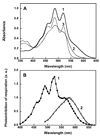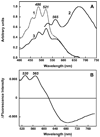Xanthorhodopsin: a bacteriorhodopsin-like proton pump with a carotenoid antenna
- PMID: 18515067
- PMCID: PMC2532838
- DOI: 10.1016/j.bbabio.2008.05.005
Xanthorhodopsin: a bacteriorhodopsin-like proton pump with a carotenoid antenna
Abstract
Xanthorhodopsin is a light-driven proton pump like bacteriorhodopsin, but made more effective for collecting light by its second chromophore, salinixanthin, a carotenoid. Action spectra for transport and fluorescence of the retinal upon excitation of the carotenoid indicate that the carotenoid functions as an antenna to the retinal. The calculated center-to-center distance and angle of the transition moments of the two chromophores are 11 A and 56 degrees , respectively. As expected from their proximity, the carotenoid and the retinal closely interact: tight binding of the carotenoid, as indicated by its sharpened vibration bands and intense induced circular dichroism in the visible, is removed by hydrolysis of the retinal Schiff base, and restored upon reconstitution with retinal. This antenna system, simpler than photosynthetic complexes, is well-suited to study features of excited-state energy migration.
Figures




Similar articles
-
Excitation energy-transfer and the relative orientation of retinal and carotenoid in xanthorhodopsin.Biophys J. 2008 Sep;95(5):2402-14. doi: 10.1529/biophysj.108.132175. Epub 2008 May 30. Biophys J. 2008. PMID: 18515390 Free PMC article.
-
Induced chirality of the light-harvesting carotenoid salinixanthin and its interaction with the retinal of xanthorhodopsin.Biochemistry. 2006 Sep 12;45(36):10998-1004. doi: 10.1021/bi061098i. Biochemistry. 2006. PMID: 16953586 Free PMC article.
-
Reconstitution of Gloeobacter violaceus rhodopsin with a light-harvesting carotenoid antenna.Biochemistry. 2009 Nov 24;48(46):10948-55. doi: 10.1021/bi901552x. Biochemistry. 2009. PMID: 19842712 Free PMC article.
-
Xanthorhodopsin: Proton pump with a carotenoid antenna.Cell Mol Life Sci. 2007 Sep;64(18):2323-8. doi: 10.1007/s00018-007-7167-y. Cell Mol Life Sci. 2007. PMID: 17571211 Free PMC article. Review.
-
Shedding new light on retinal protein photochemistry.Annu Rev Phys Chem. 2013;64:437-58. doi: 10.1146/annurev-physchem-040412-110148. Epub 2013 Jan 16. Annu Rev Phys Chem. 2013. PMID: 23331307 Review.
Cited by
-
Isolation and characterization of a main porin from the outer membrane of Salinibacter ruber.J Bioenerg Biomembr. 2022 Dec;54(5-6):273-281. doi: 10.1007/s10863-022-09950-7. Epub 2022 Oct 13. J Bioenerg Biomembr. 2022. PMID: 36229623 Free PMC article.
-
The light-driven proton pump proteorhodopsin enhances bacterial survival during tough times.PLoS Biol. 2010 Apr 27;8(4):e1000359. doi: 10.1371/journal.pbio.1000359. PLoS Biol. 2010. PMID: 20436957 Free PMC article.
-
Fluorescence Approaches for Characterizing Ion Channels in Synthetic Bilayers.Membranes (Basel). 2021 Nov 4;11(11):857. doi: 10.3390/membranes11110857. Membranes (Basel). 2021. PMID: 34832086 Free PMC article. Review.
-
Microbial rhodopsins are major contributors to the solar energy captured in the sea.Sci Adv. 2019 Aug 7;5(8):eaaw8855. doi: 10.1126/sciadv.aaw8855. eCollection 2019 Aug. Sci Adv. 2019. PMID: 31457093 Free PMC article.
-
Genome Sequence and Characterization of a Xanthorhodopsin-Containing, Aerobic Anoxygenic Phototrophic Rhodobacter Species, Isolated from Mesophilic Conditions at Yellowstone National Park.Microorganisms. 2022 Jun 7;10(6):1169. doi: 10.3390/microorganisms10061169. Microorganisms. 2022. PMID: 35744687 Free PMC article.
References
-
- Oesterhelt D, Stoeckenius W. Rhodopsin-like protein from the purple membrane of Halobacterium halobium. Nature (London), New Biol. 1971;233:149–152. - PubMed
-
- Mathies RA, Lin SW, Ames JB, Pollard WT. From femtoseconds to biology: mechanism of bacteriorhodopsin's light-driven proton pump. Annu.Rev. Biophys.Biophys.Chem. 1991;20:491–518. - PubMed
-
- Lanyi JK. Bacteriorhodopsin. Annu.Rev.Physiol. 2004;66:665–688. - PubMed
-
- Lanyi JK, Varo G. The photocycles of bacteriorhodopsin. Isr.J.Chem. 1995;35:365–385.
-
- Haupts U, Tittor J, Oesterhelt D. Closing in on bacteriorhodopsin: progress in understanding the molecule. Annu.Rev.Biophys.Biomol.Struct. 1999;28:367–399. - PubMed
MeSH terms
Substances
Grants and funding
LinkOut - more resources
Full Text Sources
Research Materials

